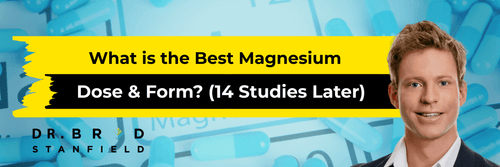There’s an engineering concept that applies here: “the best part is no part. The best process is no process.”
That concept was drilled into me during medical school and during my training as a junior doctor. Sometimes the best test is no test, and the best treatment is to avoid an unnecessary one.
But that’s not the approach that longevity clinics, which are springing up everywhere, take.

Instead, they offer an ever-growing list of tests to assess your health [1].

Behind it all, the logic feels compelling. The more information we gather, the better our health outcomes can be. We’ll spot all the problems and be able to fix them before they get worse.
But the picture is quite different in reality. More testing and more information can often lead to worse health outcomes.
When I tell my patients this, most are skeptical. So I tell them about South Korea.
Table of Contents
- The story of South Korea and thyroid cancer
- Full body scans and the cascade effect
- A sensible approach to screening
-
Reference List
The Story of South Korea and Thyroid Cancer
Something alarming happened in South Korea after 1999. The number of people diagnosed with thyroid cancer exploded. In 1999, there were 6.3 cases per 100,000 people in the population. By 2009, that number had ballooned to nearly 48. That’s more than 7 times as much [2].

And that raised an obvious question. What was going on that was suddenly causing so much thyroid cancer?
The answer isn’t what you might expect. After a careful examination of the data, researchers figured out what was driving the surge. It actually didn’t look like more people were getting thyroid cancer. Instead, doctors were just finding more cases that had been there all along. Why? Because a government-funded cancer screening initiative had led to the widespread use of ultrasound to screen for thyroid cancer [2].
Okay, so there wasn’t something environmental that was driving up cancer rates. That’s a relief. But this greater rate of detection is a win, right? We always hear that catching cancer early is key to effective treatment. So this aggressive screening program should have led to much better outcomes in terms of mortality when it comes to thyroid cancer, right?
But it didn’t. Instead, mortality rates in South Korea for thyroid cancer have remained about the same [2].
In other words, we haven’t seen better health outcomes related to thyroid cancer in South Korea, despite aggressive screening that let doctors catch many cases they used to miss.
And someone might think at this point: Well, what’s the loss? Better safe than sorry.
Have a look at this chart. It shows the number of patients who had surgery for thyroid cancer. By 2012, that number was around 11,000. In 2001, it was only about 1,000. But again, that had no noticeable impact on mortality. These surgeries weren’t saving lives. Most of them were totally unnecessary [3].

What probably happened was that many of these cancers were so slow growing that they were never going to cause an issue during a person’s lifetime. In those instances, there’s no benefit, but there are harms.
During thyroid surgery, the laryngeal nerves could be accidentally cut, causing issues with speech and swallowing. There’s infection risk, bleeding risk.
So there’s clearly a loss.
Full Body Scans and the Cascade Effect
But this isn’t just about South Korea. It’s a cautionary tale about how more healthcare doesn’t always lead to better outcomes. And the latest longevity medicine fads seem to be missing this point.
Consider full-body MRI scans. These are rising dramatically in popularity. Again, the logic sounds right. As one provider puts it, you can “catch conditions before they become crises” [4].

It’s true; you might catch the presence of a dangerous cancer. But there’s also a high chance that you’ll catch something else.
When patients get high-precision scans like CT scans and MRIs, these instruments often uncover unexpected things. They’re called “incidental findings” when they aren’t related to the reason for the scan. For instance, maybe a patient is having heart issues and they’re undergoing a scan for calcium in the arteries. But in the images, the doctor notices a mass in the patient’s lung.
Incidental findings are extremely common. They show up in 20–40% of CT or MRI scans [5].

If a patient doesn’t have any symptoms and is getting a scan as a preventative measure, everything found will be incidental. But the thing to notice here is how common it is that scans will reveal something.
But that’s a great thing, right? Now we’ve caught the presence of that secret problem so we can do something about it.
But here’s the issue: What should we do? In practice, what often happens is further exploration. The initial finding triggers what has been called a “cascade of care.” This is when physicians launch into a series of expensive additional tests and procedures, which can themselves trigger even more tests and procedures [6].
Most of the time, these incidental findings turn out to be benign. For instance, one study looked at nodules in the lung that were incidental findings in patients being scanned for plaque in their arteries. In a group of 459 people, the scan found small growths in the lungs of 81, or 18% [7].
None of those growths turned out to be cancerous. And they followed up with 63 of those 81 with additional CT scans. The growths had gone away in 35% of cases. In 62%, they hadn’t changed. In the case of 2 people, the growths had increased in size [7].
So here we see an issue slightly different from what was going on in South Korea. Instead of a problem that didn’t need to be treated, with incidental findings, we often have abnormalities that aren’t problems in the first place.
Occasionally, those full-body scans will catch a cancerous growth. But here is the completely counter-intuitive part we saw illustrated in the story from South Korea. It is often the case that cancer is slow-growing and isn’t going to do any harm if left alone. So we get no benefit from discovering it [6].
For these reasons, the logic behind full-body scans is flawed. The intent is to prevent harm through early diagnosis. But in many cases, the opposite happens. There is increased harm and no benefit [6].
And that’s why expert bodies like the American College of Radiology don’t endorse it for asymptomatic patients without obvious risk factors or a relevant family history. In a statement published in 2023, they said, “To date, there is no documented evidence that total body screening is cost-efficient or effective in prolonging life…” [8].
And we might think, “Well, can’t we do the scan and just ignore things we find that are likely to be nothing?” But imagine your doctor telling you, “So we found an unusual lump on your pancreas. But not to worry, the odds are very high that it’s nothing.” For most, the unknown can often be difficult to cope with. Many of us want to find out about that lump through further imaging and biopsies, even if there’s only a 1 in a million chance that it’s a problem.
We can see similar issues with other diagnostic services offered through longevity clinics. One provider offers a slate of over 160 lab tests, many of which are based on a blood sample [9].

Now some of these are clinically meaningful and important to check — like LDL-cholesterol levels. But for many others, the test results are completely meaningless. It’s just marketing spin to get you to pay extra.
There are two more examples I want to share with you.
The first is prostate cancer. Though it’s common, many men who have it never experience symptoms and, without screening, would never know they have the disease [10].
If cancer is diagnosed, there are various treatment strategies possible. But treatments carry significant risks of problems like erectile dysfunction and incontinence [10].
Even just the biopsy has a significant risk of adverse effects, even a slightly elevated risk of death [11].
Obviously, sometimes treatment is necessary and can save lives. But often biopsies and treatments are carried out in cases where there would not have been any problems.
On balance, the U.S. Preventive Services Task Force concluded that there is only a small potential benefit for regular screening for men aged 55 to 69. And there are substantial risks of harm [10].
And this example highlights another potential harm from screening: the anxiety and stress that comes from the findings. Even when a finding turns out to be nothing, there can be a lot of anxiety in the meantime. For many, a diagnosis of cancer is deeply distressing. In the cases where the cancer was never going to cause problems, this distress is needless and could have been avoided.
Even when nothing is found in screenings, the kind of approach taken at many longevity clinics can heighten our fear of disease and focus our attention on inactionable information that adds nothing to our health.
The final example highlights the risk of wasting money on unproven fixes to unproven problems that may give us no benefit. For instance, there’s an emerging trend to have microplastics filtered out of your blood. One clinic in London will do the procedure for a mere £10,000 [12].

But scientists aren’t yet sure whether having microplastics in our blood is a problem. And we certainly don’t know yet whether this procedure will fix it if it is. Particularly when their procedures involve plastic tubing which themselves are a hive of microplastics.
Finally, there’s the potential for financial harm. The magnitude of this harm will vary depending on how the healthcare system works where you live. But in some places, the additional tests and procedures can carry large costs. Even the initial screenings themselves can be expensive. In the U.S., those whole-body MRI scans can easily cost thousands of dollars [4].

A Sensible Approach to Screening
So do these risks mean we shouldn’t get screened at all? What’s the right approach if we want to guard our health without exposing ourselves to unnecessary harms and costs?

A starting point is to recognize that we can go wrong in either of two directions. There can be too much healthcare, as when we are aggressively screening when we lack symptoms of a problem. There can also be too little. This would be true in cases where screening has greater benefits than risks but we fail to do it. Most of us get the logic of too little healthcare. But the logic of too much is harder to see. Unless you’ve looked at examples like thyroid cancer in South Korea, it’s difficult to grasp that sometimes the best test is no test, and the best treatment is to avoid an unnecessary one.
But now that we’ve made the argument clear, where to go from here? The best way to balance potential costs and benefits is to take an evidence-based approach. Most common types of screening are carefully studied. We have a good idea of what can help produce better health outcomes and what is unlikely to. And expert bodies that study the existing evidence provide guidelines that give us a good starting place for making a decision.
For example, the American Cancer Society publishes recommendations about screening for cancer. Screenings for breast cancer, colorectal cancer, cervical cancer, and lung cancer are recommended for certain populations [13].
And your doctor is almost certainly going to recommend checking blood metrics like LDL cholesterol and Apo B. That’s because these are linked to heart disease by tons of evidence, and they are highly actionable. If our levels are elevated, we can take steps to change this.
So apart from screenings recommended based on sound data, we should be skeptical about looking for problems when we aren’t experiencing symptoms. That’s where we run the greatest risk of leaving our health (and our wallet) worse off.
And, finally, we should focus our attention on things we know move the needle most when it comes to health. We can make a huge difference in our risks for top killers like heart disease through diet and exercise.
Reference List
1. https://www.healthylongevity.clinic/programs
2. https://www.bmj.com/content/355/bmj.i5745
3. https://www.nejm.org/doi/10.1056/NEJMc1507622
5. https://www.mja.com.au/journal/2024/220/1/first-do-no-harm-responding-incidental-imaging-findings
6. https://www.ajronline.org/doi/10.2214/AJR.22.28926
7. https://pubmed.ncbi.nlm.nih.gov/18954846/
9. https://www.functionhealth.com/our-tests
10. https://jamanetwork.com/journals/jama/fullarticle/2680553
11. https://www.sciencedirect.com/science/article/pii/S0302283813005587























































